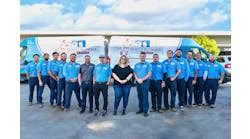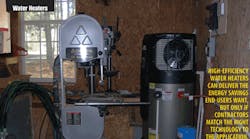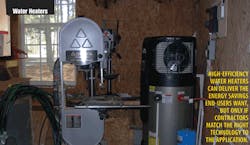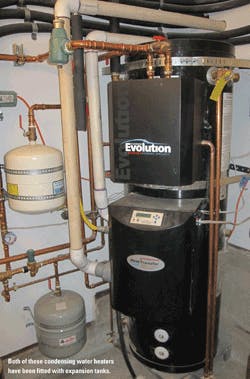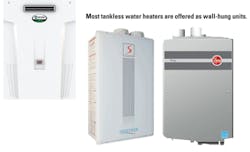Heating water costs money. According to the EPA, potable water heating is the second most expensive energy draw in the American residence, accounting for roughly 15% of a home’s energy use. If that home uses hot water for space heating — via a radiant floor system, baseboards, fan coil units, etc. — that can climb to 40%, 50% or even higher. And in commercial applications requiring high volumes of hot water such as restaurants or laundries, the cost can make or break a business.
High-efficiency water heaters can use anywhere from 10% to 50% less energy than standard models. Yet those efficiencies come with a higher price on the front end for equipment and installation, as well as special considerations such as noise, maintenance, footprint and even local climate conditions.
The key to selling high-efficiency water heating systems (and making sure the customer stays happy afterwards) is giving the end user an accurate picture of what the return on their investment will be over time. And the only way for contractors to do that is by educating themselves about the technology.
Obviously, the best place to receive training on sizing and installing is directly from the respective manufacturers. The best place for information on state and government tax breaks that can help make the initial outlay more affordable is at the EPA’s Water Sense website: www.watersense.gov.
Not every application is suited to, and not every customer will want a high-efficiency water heater. In fact, improvements in tank insulation, burner and heat exchanger technology mean that even today’s standard water heaters are much more efficient that they were just a decade ago — efficient enough for the price to satisfy many customers. But what follows is an overview on high-efficiency water heaters, how they work, and the advantages and potential pitfalls of adding them to your business.
Condensing water heaters
Jim Lunt is a principal with The Lunt Marymore Co. Inc. of Emeryville, Calif., a general contractor serving the San Francisco Bay area. He explains that a lot of the modern condensing technology “Came from the boiler industry and was adapted into water heaters.”
The basic principle is that instead of venting combustion gases directly, they are captured and utilized to heat the water even more. As more and more thermal energy is extracted from the combustion gases they condense, hence the name.
That condensate, which is acidic, needs to be disposed of. So condensing water heaters need a drain, and the drain line requires a neutralizer — basically a tube of limestone rocks that raises the pH of the condensate to a point where it can be safely disposed of. Otherwise it can eventually eat away at piping. If a suitable drain is not near the heater, a condensate pump can be used.
Another concern is venting, especially when upgrading an existing water heating system. If you make the changeover from a standard to a high-efficiency water heater “You will need a completely new flue system,” Lunt says. “You cannot use the existing masonry or single wall metal flue. You’re going to have to have some sort of plastic flue system that’s either going to the roof or to an exterior sidewall.”
Luckily, almost all condensing water heaters are power-vented, meaning venting is fairly flexible. While each manufacturer rates their product with certain types of venting material, PVC is approved for most models on the market.
Power venting means that condensing water heaters have fans. That means two things: first, they require a grounded 120-volt outlet with surge protection. Second, they make noise. “Unfortunately,” Lunt says, “these products don’t have dB ratings from the manufacturers, so you’re really relying on the knowledge of the installing contractor as to how noisy the device may be.”
The important things to consider are where you’ve terminated your flue (Lunt says to avoid anywhere near the master bedroom window!) and the sensitivities of the homeowner; what may seem loud to one person is barely noticeable to another.
Condensing water heaters may also require a larger gas line than standard heaters, and may require a reworked source of combustion air. As with standard systems, an expansion tank may need to be integrated, and a tempering valve may be needed on the hot water outlet.
Condensing water heaters can deliver from 90% to 98% thermal efficiency. According to Lunt, they are ideal for commercial restaurant applications, paying off the added expense in some cases in less than two years.
“The other amazing thing is the longevity of these beasts,” Lunt says. Because the tank in a condensing unit is made from stainless steel they never rust out, which is the number one reason for replacing a standard unit.
“I’ve got one that’s been in a restaurant for fifteen years,” Lunt says. “Sure, I’ve replaced igniters on it, I’ve even replaced a board and a blower, but if you look at the savings this owner has had over a fifteen-year life cycle, it’s thousands and thousands of dollars.”
The other aspect he touts is their versatility. Because they have a higher recovery than a standard unit they are especially suited for radiant heating applications.
Heat pump water heaters
Heat pump water heaters are the only electric-powered water heaters with high enough efficiencies to earn the government’s Energy Star rating. They can achieve this by taking advantage of a simple principle of thermodynamics: it is easier to move heat than it is to make it.
Imagine an air conditioner operating in reverse. A low-pressure liquid refrigerant is vaporized in the heat pump’s evaporator and passed into the compressor. As the pressure of the refrigerant increases, so does its temperature.
The heated refrigerant runs through a condenser coil within a storage tank, transferring its heat to the water stored there. As the refrigerant delivers its heat to the water it cools and condenses, then passes through an expansion valve where the pressure is reduced and the cycle starts over again. Since the thermal energy is coming from the surrounding air, those surroundings are the first concern of the installer.
Chris Gray, Sr., is a research engineer for Southern Co., a retail electric utility in the Southeastern U.S., covering Georgia, Alabama, Florida and Mississippi. With four million customers, Southern Co. researches every facet of energy production and consumption, including end-use appliances, which is Gray’s area of focus.
“Usually, a water heater is something you want out of sight, you don’t want it to take up much space,” Gray says. However, since a heat pump has “a fan on it, and is using a vapor compression cycle, since it’s depending on pulling energy out of the surrounding environment, it needs plenty of airflow through and around the unit.” Heat pumps require anywhere from 750 to 1,000 cubic feet of space, and airflow should be unobstructed.
Typical installation spaces are basements, attics and garages. For attic installations, the contractor needs to make sure there is sufficient structural support for the unit’s full weight.
“You want to make sure that it’s not a really dirty environment,” Gray says, “and if it is you need to make sure that the air filter is getting cleaned on a regular basis… the contractor needs to make that clear to the homeowner, or else they’re going to be getting a callback.”
Since the air surrounding a heat pump unit needs to be warm they function best in warm climates such as the South and Southwestern parts of the U.S. While all models have back up electrical heating elements for cold days, “ideally, you want to be operating on the heat pump cycle as much as possible,” Gray says, “because that’s where your efficiencies are coming from.”
As a side-effect of the heat pump cycle, the area where a unit is placed is naturally cooled and dehumidified, which can be a benefit in some areas that double as storage spaces.
As with condensing heaters, heat-pump water heaters require a dedicated electrical connection. They also require drains — and may require drain pumps in certain installations — but do not require neutralizers.
Again, because the units have both fans and condensers, noise can be an issue. The easiest way to address the problem is by locating the heater away from where people will be sleeping. Chris Gray has had more than 50 heat pump water heater owners participate in an ongoing survey over the past few years. “There’s been very few comments about the noise,” he says. “A lot of people notice it, but there have only been one or two comments about it being bothersome.”
Tankless water heaters
Tankless or on-demand water heaters are in essence powerful, specially-designed and controlled heat exchangers. They heat water only when the system calls for hot water, and consequently use exactly the energy needed to meet the hot water demand of the home. Because they don’t need to maintain the temperature of a hot water reservoir (the tank) they have no standby losses.
While long a staple in Europe and Japan, prized for both their high efficiencies and small footprint, tankless heaters — while making inroads — have yet to really take off in the North American marketplace. They present a unique set of challenges to the installer, and a missed trick at any stage can lead to poor performance for the end user. Considering the high initial outlay, that is a recipe for an upset customer.
W. B. “Butch” Aikens is the tankless sales manager for the Southeast Region for Rheem Manufacturing. He’s hoping to change people’s perception of the technology. “I encourage everyone I meet to look at tankless first, since it offers customers so much value for their money,” Aikens says, noting that tankless units can deliver thermal efficiencies from 82% to 96% and boast a much longer lifespan. “Whether it’s an unlimited supply of hot water, fuel savings or a low carbon footprint, gas tankless is always the best place to start for both residential and commercial applications.”
The first and most basic issue is accurate sizing. What is the hot water demand of the system? What is the temperature requirement of the system (120°F for residential vs. 140°F for a restaurant, for example)? What is the temperature of the incoming water? Rheem, like many manufacturers, has sizing programs which can be downloaded for free from the company website.
Next is installation. “With a gas tankless system,” Aikens says, “the general rule of thumb is that the closer I am to my fuel source and the shorter my vent, the more economical the installation.” Gas-fired tankless units need to be vented through an outside wall using stainless steel tubing. Because of their smaller footprint, there is more flexibility in locating a tankless unit than there is with a standard water heater.
But of all the installation problems Aikens regularly encounters, undersized fuel capacity ranks as the most pernicious.
With gas tankless units, the contractor needs to first ensure that the internal piping in the facility will provide the maximum Btu needed at the correct pressure. Then they need to communicate with the local fuel supplier to ensure the primary line supplying the facility will meet the Btu demand and that the meter is sized properly to meet the fuel demand. This is especially true in areas where only low pressure natural gas is available.
With an electric tankless system, things work a little differently. Aiken offers the following example: “A natural gas efficiency unit such as our RTG-95 will produce 5.6 GPM raising the temperature to 600°F, providing enough water for a standard three-bath home. To have the same 5.6 GPM produced by an electric tankless system would require two, 27-Kw electric tankless units — a total of 54 Kw at 240 volts!”
Therefore the contractor needs to contact the electrical utility to make sure service to the home will handle the addition. In most cases it will not, and the service will have to be upgraded if the excess power is available. “This is something the contractor should make a habit of doing when installing electric tankless that are 13 Kw or greater,” Aikens says.
One common critique of tankless heaters has been the “cold water sandwich” problem. As the tankless heater cycles on and off with frequent use — say, with family members getting in and out of the shower — it can introduce a section of cold water in the line between one heated section and the next. That’s the sandwich, and it shows up as a short, sudden burst of cold water.
Manufacturers have addressed this problem in different ways. Some have included small (1-gal. to 6-gal.) storage tanks. Others (including Rheem) have simply tweaked their control programming to continue operation for a few minutes after water shut off. “Our special Hot-Start programming feature is used across our entire tankless line,” Aikens explains, “and it basically elminates the cold water sandwich effect.”
Lastly, units may from time to time require descaling to ensure proper performance and optimum efficiency.
Solar, geothermal and more
While a detailed discussion of solar and geothermal water heating is beyond the scope of this article, a brief word or two is needed as they are highly efficient water heating methods, and both for the same reason: they derive the bulk of their thermal energy for free from the environment.
Solar water heating requires a flat panel solar collector typically installed on the roof. The collector is filled with a heat transfer medium, usually a glycol-based fluid. That fluid is moved through a heat exchanger and the heated water is stored in a solar thermal storage tank before being distributed throughout the facility.
Solar systems work best in sunny climates, and require a back-up water heating system for cloudy days. That system is often electric, but Jim Lunt has had success with certain condensing models. “There’s a manufacturer on the market that’s got a unit that has a built-in solar coil,” he says. “You can put one panel on the roof, plug it into your coil with a module and you’re good to go.” (Lunt cautions that to do “big solar” requires a stand-alone solar storage tank.)
Geothermal systems operate on the same principal as the heat pump described above (units are referred to as ground-source heat pumps or geothermal heat pumps). The difference is they are extracting energy from the ground and not the air. In most climates, dig just 20-ft. to 30-ft. and the temperature is a constant 50°F to 60°F., and is much more stable than air temperatures throughout the year.
The delta-T between the ground and surface is used for heating when it’s cold and cooling when it’s hot. All geothermal systems require a geothermal field. These can be wells dug vertically into the ground, or pipes or tubes laid horizontally below the frost line. Those pipes or tubes are typically made of high-density polyethylene pipe and contain a mixture of water and anti-freeze. Other types of geothermal fields — radial installation and pond installations — have been used with success.
Most installed systems have two loops on the ground side: the primary refrigerant loop is contained in the appliance cabinet where it exchanges heat with a secondary water loop — that’s the part that’s buried underground. Such closed loop systems need a heat exchanger between the refrigerant loop and the water loop, and pumps in both loops.
(Open loop systems, basically a groundwater heat pump, are also available in which the secondary loop pumps natural water from a well into a heat exchanger inside the heat pump. Heat is either extracted or added by the primary refrigerant loop, and the water is returned to a separate injection well, irrigation trench or body of water.)
As for the future of high-efficiency water heating, only two things are for sure: energy prices will continue to rise, and the technology will continue to improve. Systems will continue to strive for greater and greater efficiencies, and, as the technology becomes more widely used, those systems will gradually become more affordable.
